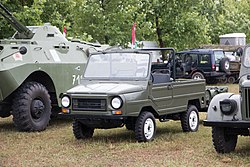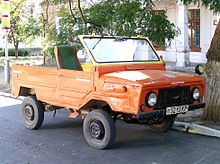LuAS-969
| ЛуАЗ | |
|---|---|
|
LuAS-969M (1979-1993)
|
|
| ЛуАЗ-969 | |
| Sales designation: | ЗАЗ-969, ЛуАЗ-969 |
| Production period: | 1967-1990 |
| Class : | Off-road vehicle |
| Body versions : | Kübelwagen |
| Engines: |
Gasoline engines : 0.9–1.2 liters (22–37 kW) |
| Length: | 3390 mm |
| Width: | 1610 mm |
| Height: | 1780 mm |
| Wheelbase : | 1800 mm |
| Empty weight : | 960 kg |
| Previous model | none |
| successor | LuAS-1302 |
The ЛуАЗ-969 , German transcription LuAS-969 , English transcription LuAZ-969 , is an off-road vehicle developed by NAMI in cooperation with SAS , which the Luzker Automobilwerk (LuAS) produced between 1967 and 1990 in four modifications (LuAS-969W, LuAS-969 , LuAS-969A, LuAS-969M). Originally the model was called ЗАЗ-969 (SAS-969), it was not until 1975 that it received the abbreviation of the manufacturer LuAS. A total of 170,683 units of the most built model LuAS-969M were built between 1978 and 1991.
development
Development of the vehicle began at NAMI in the late 1950s. The aim was to build a small off-road vehicle with a payload of 300 kg, suitable for rural areas of the USSR. Initially, the orientation was based on the Steyr-Puch Haflinger . The first prototype with the designation NAMI-049 was a Kübelwagen and had a vehicle tub with a total length of 3300 mm and a wheelbase of 1800 mm. The wheels had a countershaft to increase the ground clearance. The NAMI-049 was powered by a two-cylinder boxer engine from the Ural M-62 motorcycle with a displacement of 649 cm 3 and an output of 16 kW. The curb weight was 760 kg.
In 1961 a revised version of this prototype followed, the NAMI-049A. SAS engineers were already involved in its development . This prototype kept its wheelbase of 1800 mm, but was lengthened by 300 mm to 3600 mm. Instead of the motorcycle engine, an air-cooled four-stroke petrol engine in V4 design from the ЗАЗ-965A "Запорожец" with 887 cm 3 displacement was installed, which was throttled slightly to 19 kW by a lower rated speed. The engine was coupled to a four-speed gearbox with reduction, and the front wheels were driven. The rear-wheel drive could be engaged if necessary. The tire size was 5.90-13. Tests with the vehicle were convincing, it was given the type designation SAS-969 and was completed in 1965. However, since SAS had no production capacities available, negotiations were initially carried out on the further course of the project. Finally, the LuAS was included, it developed the vehicle until it was ready for series production. At that time, LuAS mainly built special versions of the Moskvich-432 and Moskvich-433 panel vans .
The car, the SAS-969W, which was put into series production at LuAS in 1967, differed from the originally planned vehicle. Instead of the four-speed gearbox with reduction, it has a simplified four-speed gearbox and no longer a rear-wheel drive that can be engaged, as the development of a rear-wheel drive ready for series production was delayed. With an unchanged wheelbase of 1800 mm, the vehicle was only 3270 mm long, 1560 mm wide and 1770 mm high, the vehicle tub had two side entrances and a hinged tailgate. The fuel tank is installed in front of the rear axle for better weight distribution. The engine is the same as in the prototype, but the power rating has been increased to 22 kW. The mass is 820 kg, the tire size 6.00–13, the maximum speed 75 km / h. The SAS-969W is designed for four people and 100 kg payload or two people and 250 kg payload. About 7400 vehicles were built.
Since the SAS-969W developed into an extremely successful vehicle, it was decided to also take the original vehicle concept with switchable rear-wheel drive into series production. From 1971, LuAS built the SAS-969, which technically resembles the SAS-969W, but has switchable rear-wheel drive and independent suspension. An additional crawler gear was built into the gearbox so that the vehicle could drive through difficult terrain even when fully loaded. The vehicle was built until December 31, 1974, 16,210 units were built.
In 1975 the LuAS-969A was presented, which received a revised engine with 1198 cm 3 displacement and an output of 29 kW from the ЗАЗ-966 "Запорожец" . The four-speed gearbox was revised and the countershafts were modified so that tires of size 5.90-13 could be used again and a ground clearance of 280 mm was achieved. The differential gear of the rear axle received a switchable lock. The vehicle was built until spring 1979, and 38,411 units were built.
In 1978, the completely revised version LuAS-969M was presented at the exhibition of the achievements of the national economy and the Turin Motor Show. In January 1979 the pre-series model was shown at the Auto / Moto Salon in Brussels, and series production started in the following months. The vehicle has a heavily modified appearance with a new radiator grille, modified bumpers and new door handles. The previously spartan appearance of the SAS-969 gave way to a much more modern-looking appearance. With the optionally available fabric top, this modernized version no longer looked like a vehicle from the SAS 969 family at first glance. The SAS-969M has also been technically modified compared to its predecessors. All around the vehicle was given independent suspension on parallel swing arms (pushed in front, i.e. the axis of rotation of the swing arm is behind the wheels) with torsion bar springs , the engine was now installed slightly offset to the right in the front of the vehicle (recognizable by the large protective plate on the underbody of the military Luas-969M in Picture right). Another innovation was a dual-circuit brake system with a brake booster. Drum brakes are installed all around. As a result of the changes, the vehicle mass and fuel consumption increased slightly. The Italian importer Maroelli equipped the cars imported to Italy with a liquid-cooled OHV four-cylinder in-line petrol engine of the Ford Valencia type with a displacement of 1117 cm 3 and an engine output of 37 kW. After the fall of the Wall, the LuAS-969 was replaced in 1993 by the LuAS-1302, which received a more modern liquid-cooled 1091 cm 3 OHC engine with an output of 37.5 kW from the Tawria .
Technical specifications
| Parameters | NAMI-049 | NAMI-049A | SAS-969W | SAS-969 | LuAS-969A | LuAS-969M |
|---|---|---|---|---|---|---|
| Years of construction | Late 1950s | 1961 | 1967-1971 | 1971-1975 | 1975-1988 | 1978-1991 |
| Dimensions | 760 kg | 750 kg | 820 kg | 850 kg | 940 kg | 960 kg |
| Payload | 400 kg | 400 kg | Four people + 120 kg Two people + 260 kg |
|||
| length | 3300 mm | 3564 mm | 3270 mm | 3370 mm | 3390 mm | |
| width | 1540 mm | 1560 mm | 1640 mm | 1610 mm | ||
| height | 1690 mm | 1770 mm | 1790 mm | 1770 mm | ||
| wheelbase | 1800 mm | |||||
| Ground clearance | 300 mm | 290 mm | 280 mm | |||
| Front / rear track | 1300/1320 mm | 1325/1320 mm | 1335/1330 mm | |||
| tires | 5.90-13 " | 6.00-13 " | 5.90-13 " | |||
| Engine model | ИМЗ М-62 | МеМЗ-966 | МеМЗ-969 | МеМЗ-969A | ||
| Engine type | Air-cooled two-cylinder four-stroke boxer engine, Otto | Air-cooled V4 four-stroke engine, Otto | ||||
| Mixture preparation | Carburetor | |||||
| Displacement | 649 cm 3 | 887 cm 3 | 1198 cm 3 | |||
| Bore × stroke | 78 mm × 68 mm | 76 mm × 66 mm | ||||
| Nominal power (DIN 70020) | 16 kW | 19 kW at 4000 min -1 | 22 kW at 4000-4200 min -1 | 29 kW | 31 kW at 4200 min -1 | |
| Max. Torque (DIN 70020) | 54 N · m at 2600 min -1 | 52 N · m at 2500–3000 min −1 | 74.5 Nm at 2700-2900 min −1 | |||
| Top speed | 70 km / h | 75 km / h | 85 km / h | |||
| transmission | Four-speed | Four-speed + creep speed I: 3.83: 1 II: 2.29: 1 III: 1.39: 1 IV: 0.90: 1 K: 6.73: 1 R: 4.75: 1 |
Four-speed | Four-speed + creep speed I: 3.80: 1 II: 2.12: 1 III: 1.41: 1 IV: 0.83: 1 K: 7.20: 1 R: 4.16: 1 |
Four-speed + crawler gear | Four-speed + creep speed I: 3.80: 1 II: 2.12: 1 III: 1.41: 1 IV: 0.96: 1 K: 7.20: 1 R: 4.16: 1 |
| drive | Both axes | Front axle, rear axle drive can be activated | Front axle | Front axle, rear axle drive can be activated | Front axle with switchable rear axle drive, lockable rear axle differential |
|
| Volume of the fuel tank | 34 l | |||||
| Fuel consumption | 9 l / 100 km | 10 l / 100 km | ||||
| Climbing ability | 58% | |||||
| Maximum permissible trailer mass | 300 kg | |||||
| source | ||||||
Web links
swell
- ↑ http://paul.luazzz.ru/BA.ZAZ-969.pdf Operating instructions p. 154.
- ↑ AVTOEXPORT: Contemporary prospectus of the Luas 969M , 1980s
- Jan Tuček: Auta východního bloku. Grada Publishing as, 2009, ISBN 978-80-247-2585-7 .
- Sergej Valerijewitsch Iones (Ed.): Советские полноприводные. Борус-Принт, Tula 2017, ISBN 978-5-905154-33-1 .



